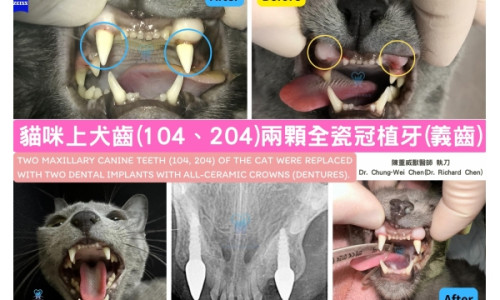狗貓植牙真的比拔牙還不痛!
很多獸醫師對於上篇的這個貓病患植牙的個案有興趣,我會同時引用人醫與獸醫的文獻說明。
齒槽骨的密度與高度是透過牙根施加在組織的壓力維持的,當牙齒脫落或被拔除時,組織不再接受壓力刺激,齒槽骨就會隨著時間逐漸流失。
根據2013年的這篇文獻,Al-Askar等學者們研究了拔牙對狗的齒槽骨有何影響,結果顯示拔牙確實會引起齒槽骨的流失,而且拔除多顆牙齒的狗,齒槽骨流失狀況會比拔除單顆牙齒的狗更明顯 (Al-Askar et al., 2013),在我的YouTube頻道《狗貓有牙齒超重要》“Teeth are very important for dogs and cats” 也有做說明與分享。
在影片2:35也有分享拔牙或缺牙導致齒槽骨流失的狗貓個案,植牙可以讓缺牙處周邊組織重新接受壓力的刺激,防止骨頭流失(Anthony et al., 2013)。
這個貓病患因為兩顆犬齒斷裂的時間點不同,開始接受植牙的時間也不同,整個療程為九個月,一個完整的植牙療程基本上為三個階段,等待骨整合的時間需要約4-6個月,每個階段的間隔時間都比齒列矯正手術長。
部分2D影像仍有影像扭曲失真的情況發生
以小動物的錐形射束電腦斷層攝影(cone beam computed tomography, CBCT)影像呈現,因狗貓的品種、體型、鼻吻長度有很大差異,3D影像可以呈現頭顱及口腔大致的結構,但2D影像仍有影像扭曲失真的情況,植牙對於CBCT的要求需要同時有2D及3D更精細的影像呈現,希望未來小動物的CBCT會有所突破。
貓狗植牙術後的疼痛評估,在第七天評分已趨近於零
關於術後疼痛的部份,在2017年的這篇文獻中,學者們針對339位的病患,分別比較封閉式拔牙、開放式拔牙、植牙、齒槽骨再生後進行植牙與牙周手術等五種手術,治療後的腫脹、出血與疼痛的Visual Analogue Scale (VAS) scores,統計結果顯示植牙在疼痛、腫脹與出血的評分,比起拔牙要更低,而且到了術後第7天,評分就已經趨近於0了,這代表了植牙後引起的疼痛、腫脹與出血是比拔牙輕微的,而且恢復的速度是快的,也沒有持續疼痛的問題 (Yao et al., 2017)。至於植牙後的牙周組織狀況,是後續追蹤的重點,如同根管治療後需要定期追蹤,植牙也需要定期持續追蹤,確保狗貓病患的植牙維持良好。
貓狗的自然齒還是最好,但當受損無法保留時,植牙會是重建的最佳方案
狗貓的根管治療、齒列矯正、牙周再生手術(Guided Tissue Regeneration, GTR)、齒槽骨再生手術(guided bone regeneration, GBR)也有發生疼痛、腫脹、神經傷害、牙齒崩裂等不適感或併發症的可能性,因為牙齒有其功能與重要性,必須盡可能保留可用的自然齒,這些治療是必須,但如果自然齒已經無法保留或脫落,植牙就是重建的最佳方案,而牙周再生手術(Guided Tissue Regeneration, GTR)、齒槽骨再生手術(guided bone regeneration, GBR)就是為了植牙做的前置作業。
就這個病例而言,我一開始的確有考慮過根管治療,但這個貓病患的牙齒斷端太接近牙齦溝,根管治療難以保留牙齒,最後必須選擇植牙,在我之前也已經有獸醫師在為狗貓進行植牙治療,2013年就有獸醫牙科專科醫師和牙醫師Drs. James Anthony, Rocco Mele and Harold Bergman提出一個論點:「獸醫牙科正在進展,但仍然比牙醫落後約20年。」(Anthony et al., 2013; Mele et al., 2017),現在是2023年,獸醫牙科對於植牙的觀念仍是原地踏步,等於落後了30年,獸醫牙科醫療尚未跟進時代也是不符合動物福利。
參考文獻
- Al-Askar, M., O’Neill, R., Stark, P. C., Griffin, T., Javed, F., & Al-Hezaimi, K. (2013). Effect of single and contiguous teeth extractions on alveolar bone remodeling: a study in dogs. Clin Implant Dent Relat Res, 15(4), 569-575. doi:10.1111/j.1708-8208.2011.00403.x
- Anthony J., Mele R., & Bergman H (2013). Dental Implants In Small Animals [Online forum comment]. Retrieved from: https://www.veterinarypracticenews.com/dental……/
- Mele, R. E., Caiafa, A., & Kurtzman, G. M. (2017). Feline Dental Implants: Long-Term Follow-up of Two Cases. J Vet Dent, 34(4), 268-278. doi:10.1177/0898756417734313
- Yao, J., Lee, K. K., McGrath, C., Wu, Y. N., Li, K. Y., & Mattheos, N. (2017). Comparison of patient-centered outcomes after routine implant placement, teeth extraction, and periodontal surgical procedures. Clin Oral Implants Res, 28(4), 373-380. doi:10.1111/clr.12794
Many veterinarians are interested in my cat’s patient of dental implants, and I will cite both human and veterinary literature in my explanation.
The density and height of alveolar bone are maintained by the pressure exerted on the tissues by tooth roots. When teeth are lost or extracted, the tissues no longer receive this pressure, leading to gradual alveolar bone loss over time.
According to a 2013 study by Al-Askar et al., the researchers investigated the effects of extraction on alveolar bone in dogs. The results showed that extraction indeed caused bone loss, and dogs with multiple teeth extracted exhibited more significant alveolar bone loss compared to dogs with a single tooth extracted. (Al-Askar et al., 2013). In my YouTube video “Teeth are very important for dogs and cats” (https://youtu.be/HfozEv7mpZo) at 02:35-03:05, I also shared patients of dogs and cats experiencing alveolar bone loss due to extraction or missing teeth. Dental implants can allow the surrounding tissues to receive pressure stimulation again, preventing bone loss (Anthony et al., 2013).
This cat patient began dental implant treatment at different times due to the different timing of two fractured canines, the entire treatment course lasted for nine months. A complete dental implant procedure typically consists of three stages, the waiting time for osseointegration takes about 4-6 months. The intervals between each stage are longer than those in orthodontics.
Cone beam computed tomography (CBCT) imaging in small animals can present a rough structure of the skull and oral cavity, but 2D imaging still suffers from distortion. Dental implants require more precise 2D and 3D imaging through CBCT to meet the requirements. It is hoped that future advancements in small animal CBCT will address these challenges.
Regarding postoperative pain, in a 2017 study by Yao et al., researchers compared five different procedures involving 339 patients, including closed tooth extraction, open tooth extraction, dental implantation, and periodontal surgery after alveolar bone regeneration. They used the Visual Analogue Scale (VAS) to assess swelling, bleeding, and pain scores. The results indicated that dental implantation had lower scores for pain, swelling, and bleeding compared to extraction, and by the 7th day after surgery, the scores approached zero. This suggests that postoperative pain, swelling, and bleeding from dental implants are milder and recover quickly, without persistent issues (Yao et al., 2017). However, the condition of periodontal tissues after dental implantation requires ongoing monitoring, similar to the regular follow-ups needed after endodontics.
Endodontics, orthodontics, guided tissue regeneration (GTR), and guided bone regeneration (GBR) in dogs and cats also carry the possibility of experiencing discomfort, swelling, nerve injury, tooth fractures, or other complications. Since teeth serve vital functions and are crucial, every effort should be made to preserve viable natural teeth, and these treatments are necessary. However, if natural teeth cannot be retained or have already been lost, dental implants become the optimal reconstruction option, and guided tissue regeneration (GTR) and guided bone regeneration (GBR) serve as preparatory procedures for dental implants.
In this patient, I did consider endodontics initially, but the location of the fractured teeth in this cat patient was too close to the gingival sulcus, making it difficult to preserve the teeth through endodontics. Ultimately, dental implants had to be chosen. Prior to my treatment, other veterinarians had already been performing dental implant procedures for dogs and cats. In 2013, veterinary dental specialist and dentist, including Drs. James Anthony, Rocco Mele, and Harold Bergman, made an argument: “Advances in veterinary dentistry are being made, still about 20 years behind of human dentistry” (Anthony et al., 2013; Mele et al., 2017). Now, in 2023, the concept of dental implants in veterinary dentistry is still stagnant, lagging behind by approximately 30 years. The lack of progress in veterinary dental care and the failure to keep up with the times are not in line with animal welfare.
References:
Al-Askar, M., O’Neill, R., Stark, P. C., Griffin, T., Javed, F., & Al-Hezaimi, K. (2013). Effect of single and contiguous teeth extractions on alveolar bone remodeling: a study in dogs. Clin Implant Dent Relat Res, 15(4), 569-575. doi:10.1111/j.1708-8208.2011.00403.x
Anthony J., Mele R., & Bergman H (2013). Dental Implants In Small Animals [Online forum comment]. Retrieved from: https://www.veterinarypracticenews.com/dental……/
Mele, R. E., Caiafa, A., & Kurtzman, G. M. (2017). Feline Dental Implants: Long-Term Follow-up of Two Cases. J Vet Dent, 34(4), 268-278. doi:10.1177/0898756417734313
Yao, J., Lee, K. K., McGrath, C., Wu, Y. N., Li, K. Y., & Mattheos, N. (2017). Comparison of patient-centered outcomes after routine implant placement, teeth extraction, and periodontal surgical procedures. Clin Oral Implants Res, 28(4), 373-380. doi:10.1111/clr.12794



